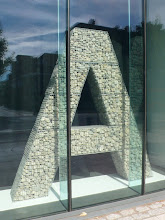
The memory of it (unlike the name) stayed with me. A few months ago I did Janet Cardiff's audio walk The Missing Voice (case study B) from Whitechapel Art Gallery. Not only did I put two and two together and remember the work from the Tate all those years ago, but I also got a bit carried away and wrote shed loads about the walk in my thesis draft. Honestly, go and do it, it really is great.

Now clearly I am interested in exploring place through the medium of print not sound, so my enthusiastic writing has since been cut, but I still think there are some useful parallels and differences that could be worth exploring both theoretically and practically. Having now read the essays in Janet Cardiff & George Bures Miller: The Killing Machine and other stories 1995-2007, I can even articulate what some of those things might be. The walks engage one via a 'soundtrack' that has both real and 'artificially' constructed elements, blurring the distinction between the world outside and within the headphones. By following the 'score' (as in music not football) the walker becomes a participant, rather than a spectator, acting out or performing the walk and realising its potential. In the book, Mari (p 15-16) puts the roots of this type of work in the Fluxus movement.
So how does this relate to my work? In order to translate the experience of place into print one will need to engage the reader in a pro-active, interactive way. There needs to be an element of the reader taking control, and literally taking a journey through the work (and therefore the place) themselves. In effect the reader (to get into Barthesian territory) needs to become the author in the way that in Cardiff's work the spectator becomes the actor. What I think will differ from Cardiff's work is how that is scored, scripted or dictated. The idea of a score implies something that is written down and has very clear parameters in terms of timing and execution. Even with the possibility of interpretation through a conductor, this seems too fixed for what I am trying to achieve. Cardiff's walk is very clearly scripted. One literally follows the pace of the footsteps on the recording and the verbal directions as to where to cross, where to turn right, and so on, and really it could be no other way or the narrative would not work. However, my work needs to encourage greater exploration of place. The parameters need to be wider. If its music, perhaps it is a riff that is then explored in a more freeform way? What a revolting analogy, but do you see what I mean? How one does this I don't know, though I am pretty sure one can experiment physically with the form of a book to speed up/slow down the reader. I was thinking of flicking through the pages of a magazine as being like getting from A-B in the fastest way possible, disinterested in twists and turns that are off route. Could it be possible to slow people down, or encourage them to explore via the design? I think it could, so I need to explore these ideas physically AND STOP JUST TALKING ABOUT THEM!


No comments:
Post a Comment